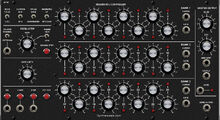
Synthesiers.com Q119 analog sequencer
In the context of modular synthesizers, a sequencer generates a series of control voltages and gate signals, usually intended to cause the synth to play a repeating series of notes. (In this application, the control voltage that is output is usually routed to a voltage controlled oscillator to control its frequency, and the gate signal is routed to an envelope generator to control the sounding and dynamics of the notes.) The typical sequencer in a modular synth is capable of 8 or 16 steps, whose outputs are all tied to a common output bus. Each step has knobs which determines the control voltage and the duration of the gate signal that the step generates. A counter determines which step is in control of the output bus at a given time; the counter is advanced by an applied clock signal, which determines the tempo of the played notes. Most sequencers will have manual controls for stop, start, and reset (return to the first step). Some have built-in clock generators which can be used to run the sequencer without an external clock source, although the external clock input provides more flexibility.
Improvements and additions include multi-row designs and output row/bus selectors. A multi-row sequencer has two or more control voltage output knobs, each of which outputs a selected control voltage on a separate output bus or "row" when that step is active. A row selector can be set up to route a desired row to its output, and to change the selected row each time the sequencer loops through; this effectively multiplies the total length of the sequence that can be played, e.g., an 8-step, three-row sequencer can play a sequence of up to 24 individual notes. Or, different rows can be fed to different VCOs to play sequenced chords. Other possible improvements include the ability to "reset" at a given step or to skip selected steps, either of which allows sequences of different lengths to be played. A few sequencers have controls allowing the duration of a step to be increased or decreased, or to select whether a given step causes the gate output to be cycled (allowing notes to be held across steps). At the opposite extreme from the multi-row sequencer is the gate sequencer, which does not produce control voltages, only gate signals.
The analog sequencer first appeared in the 1960s; they were expensive and temperamental beasts, and not very flexible. The basic design of analog sequencers today remains the same; main improvements have been in reliability and additional features, and some modern designs actually use digital circuitry to control the step selection. (They are still referred to as "analog" sequencers nonetheless.) The use of this type of sequencer remains mostly confined to use with modular synths.